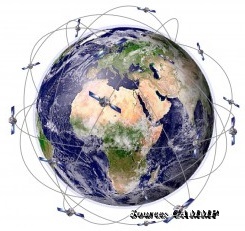How does GPS actually work and what does this have to do with maths?
 In the GPS module, the pupils gain insights into the functioning of navigation satellite systems for position determination, which are particularly interesting for the young people due to their own everyday use in the car, on the bicycle, in the smartphone or even in the camera. GPS works with the help of satellites that orbit the earth at an altitude of up to 20,000 km. The satellites are equipped with an atomic clock and continuously send the current time to Earth. GPS devices receive this information and can use it to calculate their own position.
In the GPS module, the pupils gain insights into the functioning of navigation satellite systems for position determination, which are particularly interesting for the young people due to their own everyday use in the car, on the bicycle, in the smartphone or even in the camera. GPS works with the help of satellites that orbit the earth at an altitude of up to 20,000 km. The satellites are equipped with an atomic clock and continuously send the current time to Earth. GPS devices receive this information and can use it to calculate their own position.
In this module, the students deal with position calculation in GPS devices and their optimization. Among other things, the students calculate their own position with the help of GPS raw data. Specialist competences in the areas of analysis, trigonometry and algebra are trained to a high degree.
This module is recommended for mathematics courses of the upper school, which deal with vectors in space at the time of the CAMMP day or for physics courses, which can explore an application of the theory of relativity in this module. Thus the module serves as a supplement to the lessons. However, the module can also be carried out without understanding the concept of vectors.
Duration: from 5 hours (incl. lunch break)
Contents: systems of equations, tangent equations in three-dimensional space, equilibrium calculus
Previous knowledge: Setting up linear equations
Target group: Upper secondary mathematics courses
Created by: Pascal Richter, Christina Roeckerath, Markus Wiener
Registration: Appointments can be made individually by e-mail at KIT or RWTH Aachen University.
Material
The interactive learning material can be accessed via the online platform workshops.cammp.online. How to create an account on the platform and use the
material is explained in this video. In addition, accompanying material is provided for teachers on the online platform, which can be accessed via a password that can be requested by e-mail.
List of publications and talks to this modul:
- Frank, M.; Richter, P.; Roeckerath, C.; Schönbrodt, S. (2018); Wie funktioniert eigentlich GPS? – ein computergestützter Modellierungsworkshop, In: Digitale Werkzeuge, Simulationen und mathematisches Modellieren, Springer Fachmedien: Wiesbaden.
-
Wiener, M.: Didaktisch-methodische Ausarbeitung eines Lernmoduls zum Thema GPS mit Hilfe von Matlab im Rahmen eines Modellierungstages für Schülerinnen und Schüler der Sekundarstufe II, Schriftliche Hausarbeit im Rahmen der Ersten Staatsprüfung für das Lehramt an Gymnasien und Gesamtschulen, 2015.
